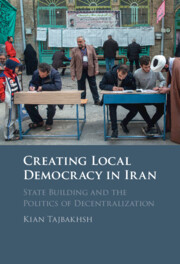Book contents
- Creating Local Democracy in Iran
- Creating Local Democracy in Iran
- Copyright page
- Contents
- Figures
- Tables
- Preface: Stumbling on Local Democracy (My Personal Journey)
- Acknowledgments
- Overview of the Book
- Abbreviations
- Part I Launching Local Democracy
- 1 Reshaping the State
- 2 Launching Municipal Government, 1999–2003
- Part II Arguing for Local Democracy
- Part III Blocking Local Democracy
- Index
1 - Reshaping the State
Political Decentralization Comes to Iran in the 1990s
from Part I - Launching Local Democracy
Published online by Cambridge University Press: 07 July 2022
- Creating Local Democracy in Iran
- Creating Local Democracy in Iran
- Copyright page
- Contents
- Figures
- Tables
- Preface: Stumbling on Local Democracy (My Personal Journey)
- Acknowledgments
- Overview of the Book
- Abbreviations
- Part I Launching Local Democracy
- 1 Reshaping the State
- 2 Launching Municipal Government, 1999–2003
- Part II Arguing for Local Democracy
- Part III Blocking Local Democracy
- Index
Summary
Chapter 1 describes the motivations of the Islamists, who crafted what became the 1996 Local Councils Law. In the face of protests and riots in the nation’s cities, Islamist lawmakers in the fourth Islamic Majles (1992–1996) turned to political decentralization to address poorly managed urbanization and local governance as a way of easing economic stresses among lower economic classes that had spurred unrest. The chapter explores the 1996 Local Councils Law in detail, including the structure and the responsibilities of elected local government comprising three institutions: the elected Islamic city council (shura-ye eslami shahr), the mayor (shahrdar), and the municipal bureaucracy (shahrdari). The chapter goes on to explain the institutional design and structure of elected local government and its place in the intergovernmental system resulting from the decentralization reforms. It highlights the tension between two parallel vertical systems of hierarchical governance, between the top-down appointed system bureaucratic hierarchy and the bottom-up. The contradiction between the two systems results from the tension between two counterpoised systems of upward and downward accountability.
Keywords
- Type
- Chapter
- Information
- Creating Local Democracy in IranState Building and the Politics of Decentralization, pp. 3 - 39Publisher: Cambridge University PressPrint publication year: 2022



